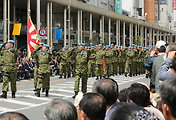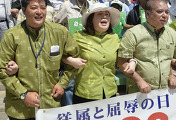더글러스 러미스 | 미국 정치학자, 오키나와 거주
몇년 전, 기밀 해제된 미국 전략사령부의 한 문서에는 다음과 같은 내용이 담겨 있다.
| “우리가 수용할 수 없는 행동 또는 피해를 명시적으로 규정하고 소통하는 것도 중요하지만, 우리의 대응을 너무 구체적으로 밝혀서는 안된다. 우리가 억지하려는 적의 행동이 나타나려 할 때 미국이 적에게 가할 수 있는 조치의 모호성에서 비롯되는 장점 때문에 우리가 너무 충분히 합리적이고 냉정한 존재로 그려지는 것은 손해이다. 일부 요소는 잠재적으로 ‘통제 불가능’해질 수도 있음을 보여주는 것이 적국 정책 결정자들의 마음 속에 두려움과 의구심을 만들고 강화시키는데 이로울 수 있다. 두려움의 본질은 실제로 작동하는 억지력에 있다. 핵심 이익이 공격받을 경우 미국도 ‘비합리적이고 복수심에 가득찰 수 있음’을 보여주는 것이 우리가 모든 적들에게 투사하고자 하는 국가적 페르소나의 한 부분이 되어야 한다.” |
리처드 닉슨과 헨리 키신저는 이를 ‘미치광이 전략’이라고 불렀다. 핵무기가 억지력으로 작용하려면 단순히 핵무기를 보유하는 것만으로는 불충분하다. 문제는 보통의 인간적 감정이나 이성을 가진 사람이라면 어느 누구도 실제로 그걸 사용하려 하지 않을 것이라는 점이다. 핵무기에 의한 첫번째 타격은 도덕적으로 매우 꺼림칙한 일이 될 것이고, 두번째 타격은 이미 때가 너무 늦은 뒤의 일일 것이기 때문이다. 핵무기가 효과적인 억지력을 갖기 위해서는 정부는 적들에게 자국 지도자가 핵무기를 쓸 정도로 미치광이라는-위 문서 표현에 따르자면 ‘통제 불가능한’ 또는 ‘비이성적이고 복수심이 강한’-점을 납득시켜야 한다.

따라서 이것은 미국 대통령이 누구냐의 문제는 아니다. 누가 대통령이든, 미치광이 전략은 미국 정책의 한 부분이다. 미국은 실제 핵무기를 사용할 정도로 정부 내에 미친 사람이 있다는 사실을 적국들에 납득시켰다는 점에서, 그러한 미치광이 전략은 성공했다. 적국뿐만 아니라 나 역시 그렇게 이해하고 있다. 어쨌든 미국은 핵무기를 실제 사용함으로써 언제든 그걸 쓸 수 있음을 입증한 유일한 나라다.
의도했건 안 했던 조선민주주의인민공화국 정부 역시 적들에게 이러한 (미치광이) 국가적 페르소나를 투사하는데 성공했다. 이 글을 쓰고 있는 4월7일 현재 미국과 북한은 쿠바 미사일 위기 이후 가장 위험한 핵 대치를 벌이고 있다. 북한 당국은 핵 공격 준비가 돼 있다고 말한다. 미국 당국은 북한은 핵 공격이 자살행위임을 잘 알고 있기 때문에 그러지 못할 것이라고 말한다. ‘자살’이란 표현에서 보듯, 미국 역시 보복 타격을 할 때는 핵으로 할 것임을 시사한다.
북한은 지난 60년간 미국의 핵 공격 위협 아래서 살아왔다. 그 기간 대부분 북한은 어떠한 핵 억지력도 갖추지 못한 채였다. 그러한 경험이 그 나라의 합리성을 증진시켰을까, 아니면 서서히 나타나는 외상후스트레스장애-피해망상증과 분노에 찬 공격, 돌발적인 통제불능한 폭력-를 가져왔을까. 후자이기를 바라지는 말자.
대한민국의 햇볕정책이 막 닻을 올린 2000년 9월 ‘새로운 미국의 세기를 위한 프로젝트’라는 이름의 미국 네오콘 싱크탱크는 ‘미국 방위의 재건’이라는 제목의 보고서를 발간했다. 거기엔 이런 문장이 있다.
“(…) 어떠한 현실적인 (한반도) 통일 이후 시나리오에서도 미군은 북한에서 안정화 작전의 한 역할을 담당할 것 같다.” 이러한 관점에서 ‘한반도 통일’은 “한반도 북부에 대한 미군의 군사적 점령”을 의미했다. 2개월 뒤 조지 W. 부시가 대통령에 당선되자, 이 보고서 작성에 참여한 많은 이들이 미 행정부에 기용됐다.
2년 뒤인 2002년 1월29일 부시 대통령은 이라크, 이란, 북한을 ‘악의 축’으로 선언했다. 당시 미국은 이라크를 침공할 준비를 시작했다. 의미심장하게도 유엔 무기감시단이 이라크에 대량살상무기가 없다고 확인한 뒤 미국은 이라크를 침공했다. 이라크에는 어떠한 억지력도 없었다.

북한 관리들은 이러한 사태 전개를 주시했다. 짐작컨대 북한 사람들이 이 일에서 얻은 교훈은 ‘악의 축’ 명단에 있는 나라 중에 핵 억지력을 갖고 있지 않으면 미국에 침공당한다는 것일 것이다. 미국이 이라크를 침공한다는 게 분명해졌을 때인 2003년 1월 북한은 핵확산방지조약(NPT) 탈퇴를 선언했다. ‘악의 축’은 부시의 구호였다. 하지만 다시 말하건대 누가 대통령인지는 중요하지 않아 보인다. 지난달 미군과 한국군은 북한에 대한 모의 핵공격 훈련 및 북한 침공 시나리오에 기반을 둔 워게임을 수행했다. 침공은 여전히 미국의 한반도 통일 모델의 하나이고, 핵 공포는 여전히 하나의 옵션으로 남아있다. 북한의 반응이 미친 것처럼 보이기도 한다. 하지만 그들이 미치광이 전략을 오용하는 것인가, 아니면 60년간 미국의 핵 위협 아래 살아오면서 진짜로 미쳐버린 것인가.
| Nuclear Terrorism A US Strategic Command document declassified a few years ago contains the following passage: (...) While it is crucial to explicitly define and communicate the acts or damage that we would find unacceptable, we should not be too specific about our responses. Because of the value that comes from the ambiguity of what the US might do to an adversary if the acts we seek to deter are carried out, it hurts to portray ourselves as too fully rational and cool - headed. The fact that some elements may appear to be potentially “out of control” can be beneficial to creating and reinforcing fears and doubts within the minds of an adversary‘s decision makers. This essential sense of fear is the working force of deterrence. That the US may become irrational and vindictive if its vital interests are attacked should be a part of the national persona we project to all adversaries. (...) Richard Nixon and Henry Kissinger called this the Madman Strategy. For nuclear weapons to serve as a deterrent, it’s not enough simply to possess them. The problem is, no person of ordinary human feeling or rationality would actually use them. A first strike would be a moral abomination; a second strike would be too late. For nuclear weapons to be an effective deterrent, a government must persuade adversaries that its leaders are crazy enough to use them - as the document says, “out of control”, “irrational and vindictive”. Thus it‘s not a question of who is the US president. Whoever is president, the Madman Strategy is US policy. And it has succeeded, in that the US’s adversaries are persuaded that there are people in the US government mentally deranged enough to use the Bomb. I am also persuaded. After all, the US is the only country to prove itself capable of doing it by actually doing it. Twice. Whether intentional or not, the government of the Democratic People‘s Republic of Korea has also been successful in projecting this national persona to its adversaries. As I write (7 April) the US and the DPRK are engaged in the most dangerous nuclear standoff since the Cuban missile crisis. DPRK representatives are saying they are ready to launch a nuclear attack. US representatives are saying, probably they won’t do it, because they are rational enough to understand that it would mean suicide. By “suicide” they mean that the US would take revenge by launching a nuclear attack. The DPRK has been under threat of US nuclear attack for six decades, most of that time without any nuclear deterrent capability. Does such an experience improve one‘s rationality, or does it bring on a slow version of PTSD: paranoia, attacks of rage, sudden uncontrollable violence? Let’s hope not the latter. In September 2000, as the ROK‘s Sunshine Policy was just getting started, a neoconservative US think tank called The Project for the New American Century published a paper titled “Rebuilding America’s Defenses.” It contained the sentence, “…in any realistic post-unification scenario, U.S. forces are likely to have some role in stability operations in North Korea.” In this view, “reunification of Korea” meant “US military occupation of the North”. After George W. Bush was elected president two months later, many of the authors of this document joined his administration. Two years later, on 29 January, 2002, President Bush declared that Iraq, Iran, and North Korea formed an “axis of evil”. Then the US began preparations to invade Iraq. Significantly, it invaded Iraq only after it was assured by the UN Weapons Inspection Team that Iraq had no weapons of mass destruction: no “deterrent”. Surely the DPRK officials watched these developments closely. Presumably the lesson they drew from them was, countries on the “axis of evil” list that have no nuclear deterrent get invaded by the US. In January, 2003, when it had become clear that the US was going to invade Iraq, the DPRK announced its withdrawal from the Nuclear Non-Proliferation Treaty. “Axis of evil” was a GW Bush slogan, but again it seems not to matter who is president. Last month the US military in the ROK staged a mock nuclear attack on the DPRK, and carried out a war game on the scenario of invading that country. Invasion is still the US model for reunification, and nuclear terror is still an option. The response of the North appears to be mad, but is it an overuse of the Madman Strategy, or have six decades of living under US nuclear threat driven them genuinely mad? |
<번역 | 손제민 기자>
'=====지난 칼럼===== > 더글러스 러미스 칼럼' 카테고리의 다른 글
| 일본 자민당이 헌법을 개정하려는 진짜 이유 (0) | 2013.06.11 |
|---|---|
| 주권회복의 날? 굴욕의 날! (0) | 2013.05.14 |
| 이라크 전쟁 10돌, 테러리스트 정부 (0) | 2013.03.11 |
| ‘배신자는 떠나라’는 일본 우파 (0) | 2013.02.11 |
| 자민당이 그리는 일본의 모습 (0) | 2013.01.14 |




댓글